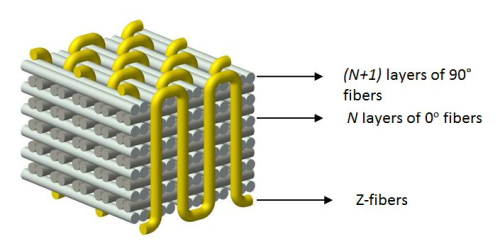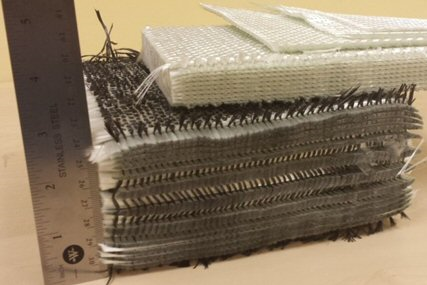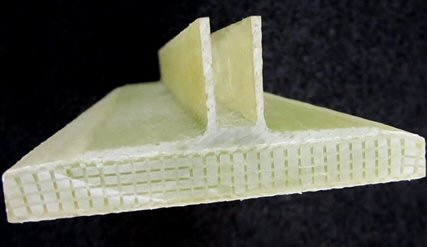



The expanded use of composites in marine and aircraft structures has led to a heightened interest in using these materials to replace metals in automobiles, trucks, and buses. Structural components for these applications will be based on continuous fibre reinforcements, which have traditionally been 2D fabrics based on glass, carbon or aramid fibres. Achieving the desired part thicknesses tends to require many layers of 2D textile reinforcements.
Delamination in 2D composite laminates is the most frequent failure mode of these composites. Cracks can form in the resin matrix material and then spread quickly along the resin-rich areas between the layers of fibre reinforcement. These cracks can form due to a variety of reasons, ranging from differential strains imposed on the layers in the composite, to edge damage that occurs during cutting, to out-of-plane impacts from falling tools or other objects.
SAERTEX 3D fabrics and 3D billets, with reinforcement fibres incorporated through the thickness as well as in the 0° and 90° directions, provide several advantages:
- producing the reinforcements at greater thicknesses requires less effort in the cutting and placement of the fabrics in the mould;
- placing reinforcement fibres through the thickness prevents delamination.
“The addition of 3D fabric to our 2D multiaxial NCF business is a perfect fit for certain markets and applications where increased structural strength in the third dimension is desired,” SAERTEX USA, LLC General Manager Dr. Christian Kissinger comments.
“The investment in 3D fabric machinery and equipment allows us to produce these fabrics for the American and global markets at SAERTEX’s known high level of service, quality and reliability.”
Some of the current applications for SAERTEX 3D fabrics and 3D billets are marine hulls and structural components, large industrial structures, industrial storage tanks, components for oil drilling, attachment points for bus bodies, ballistic protection, and amusement park structures. Examples of such structures are shown in Figure 1.
3D fabrics
In contrast to 2D woven fabrics, SAERTEX 3D fabrics and 3D billets consist of three basic parts: 0°, 90° and through-thickness fibres, called Z-fibres, as shown in Figure 2. Almost any fibre type can be used in the 0°, 90° and Z directions. Also, the highly aligned fibres form distinct resin flow paths, in turn producing fast infusion rates through these fabrics.
SAERTEX 3D fabrics and 3D billets differ from traditional 3D woven fabrics in several ways. The most important difference is that the in-plane (0° and 90°) fibres have no crimp. Therefore, composites made from the SAERTEX 3D fabrics/billets have a greater in-plane tensile strength than composites made of traditional 3D woven fabrics or made of laminates of 2D woven fabrics.
The primary difference between the SAERTEX 3D fabrics and SAERTEX 3D (Figure 3) billets is the thickness. The fabrics can be shipped in large rolls. They can have a thickness up to 3 mm (0.12 inch) and a width of up to 1525 mm (60 inch). The billets are shipped as flat pieces. They can reach up to 50 mm (1.97 inch) thickness in a single fabric layer with a width of up to 838 mm (33 inch).
Fabrics with a number of raw materials have been produced in the SAERTEX 3D fabric/3D billet machines, including:
- E-glass and S-glass;
- aramids such as Kevlar and Twaron;
- PAN carbon fibres and pitch carbon fibres; and
- special fibres such as alumina, silica, PE, UHMWPE, and stainless steel yarns.
SAERTEX 3D fabrics bring superior performance and processing benefits for composite parts including high resin infusion speed and reduced lay-up time. As an example of the increased infusion speed, one layer of 3260 g/m2 (96 oz/yd2) was shown to infuse more than twice as quickly as a four-layer laminate of 820 g/m2 (24 oz/yd2) 2D woven fabrics. Using a single full thickness SAERTEX 3D fabric can reduce the cutting and lay-up time significantly.
SAERTEX 3D fabric shows exceptional delamination suppression which leads directly to several benefits in the composite’s performance:
- increased fracture toughness;
- improved impact resistance and damage tolerance; and
- enabling machining without edge delamination.
Control of the motion of the Z fibres provides a method of making a single integral fabric that contains multiple sets of thicknesses, or 'splits.' Folding the 'split' areas can then form the fabric into a number of simple shapes, such as an 'I' beam, an 'H' coupler or the 'π' that is shown in Figure 4. Such shapes have been shown to increase the strength of composite joints compared to those formed by 'L' shaped laminates of 2D woven fabrics. ♦
This article was published in the September/October 2014 issue of Reinforced Plastics magazine.
The digital edition of Reinforced Plastics is distributed free of charge to readers who meet our qualifying criteria. You can apply to receive your free copy by completing this short registration form.




